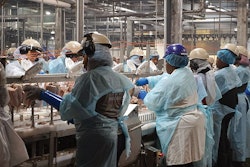
Feed costs, recently subdued, may threaten poultry companies again in 2019.
From the end of the 2013-14 marketing season through April 2019, corn rarely topped $3.75 per bushel. Historic flooding then stymied planting efforts, stoking bullish sentiments. Roughly two-thirds of intended corn plantings were completed by June, well short of the five-year average of 96%. This spooked traders into bidding up December corn futures, which rallied to nearly $4.70 per bushel by mid-June. While the price reaction in the soybean complex was tame by comparison, echoes of prior feed cost shocks were suddenly heard.

Feed input costs are projected to increase at least 5% to 10% in 2020. Corn carries the greatest upside price risk.
USDA calms market temporarily
Given the challenges U.S. farmers faced this spring, anticipation of the U.S. Department of Agriculture’s (USDA) National Agricultural Statistics Service (NASS) June 2019 Acreage report seemed stronger than usual. Observers were surprised to see corn planted acreage estimated at 91.7 million, not far below the 92.8 million acres the USDA estimated in its March 2019 Prospective Plantings report and up 3% from the year-prior total. Soybean planted acreage was pegged at 80.0 million, representing a much larger cut from March intentions of 84.6 million.
The acreage mix represented something of a best-case scenario for poultry companies. Corn was at risk of continued appreciation, but the larger-than-expected acreage report created some breathing room. With USDA projecting 2018/19 ending soybean stocks at more than 1 billion bushels, and the complex burdened by ongoing demand concerns, there was plenty of room for soybean acreage to come down without risk of a price rally.
Poultry companies not out of the woods yet
Both corn and soybean meal futures initially reacted negatively to the June 2019 report. However, neither came crashing back to earth in the first few weeks after its release, either.
It’s reasonable to believe the USDA missed late-season changes of plans by many farmers, which occurred more frequently this year than most, due to its June survey reference date. The August survey should answer lingering questions. It’s a safe bet that corn acreage will be revised at least slightly lower then.
Beyond that, corn and soybean condition ratings are uninspiring. Barring a run of perfect weather the rest of the growing season, crop yields will be subpar. Increasingly, it appears we could see an average U.S. corn yield of about 160 bushels per acre or lower in 2019. Coupled with potential acreage revisions, the additional grace created by USDA’s June 2019 report could quickly disappear.
How much will feed costs increase?
Even if the situation unfolds favorably for poultry companies, corn is poised to maintain a floor in the area of $4 per bushel through the 2019-20 marketing season. With just a few tough breaks, there’s a pretty clear path for corn to hold at about $4.50 per bushel and possibly make a run at $5 per bushel.
While the upside potential for soybean meal is more limited, poultry companies are still looking at corn driving at least a 5% to 10% increase in average overall feed input costs in 2020. That would make it the most challenging year from a feed cost perspective since 2014.

















